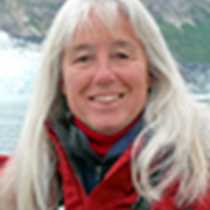Glacier Bay National Park, Alaska
The Sea Lion quietly docked at Bartlett Cove in the early morning hours. At 6:00 am National Park Service ranger Linda Lieberman embarked and we departed the pier. Linda brought Glacier Bay National Park maps with her and spent the day interpreting and sharing the natural, cultural and recent history of the park.
We cruised toward a bright spot in the overcast sky which would later break open to reveal the high peaks of the Fairweather Range. These mountains capture moisture and spawn glaciers, some of which have carved Glacier Bay. Since the last glacial advance during the Little Ice Age, the ice has rapidly retreated about 65 miles to expose the waterway that allows sea-going vessels to enter with visitors who can marvel at the spectacular scenery and tidewater glaciers that remain. Massive Mount Fairweather rises 15,320 feet directly from sea level, its rounded summit sporting a perennial snow cap.
After breakfast we stopped by South Marble Island to see nesting seabirds and Steller sea lions that haul out here. Black-legged kittiwakes, glaucous-winged gulls, common murres, pigeon guillemots, and the lovable, colorful puffins, both tufted and horned, were among the species of birds that mate and raise young here before migrating out to the open ocean until next spring.
Further along, a young brown (grizzly) bear was spotted turning over rocks along the shoreline looking for goodies to lap up underneath. Bears will eat a variety of food, depending upon what is available to them during the season.
At Gloomy Knob, a gray mass of limestone with little vegetation, we spied some mountain goats on the precipitous cliffs. With specially adapted hoofs, the nimble goats are able to get around on the steep slopes and avoid potential predators such as wolves and bears. Sometimes gravity gets the best of them, however.
Now in bright sunshine, Margerie Glacier gleamed next to the fudgy terminus of Grand Pacific Glacier at the end of Tarr Inlet. Snowy peaks were in contrast to the blue sky. Both glaciers cracked and grumbled as we paused and listened and watched. Then a narrow pinnacle crumpled and toppled into the sea with a tremendous crash and a splash – “white thunder” – just what we’d been waiting for.
We turned to retrace our wake back down the bay, passing by a wall dotted with kittiwake nests. The birds are near their food source and take advantage of stunned fish and krill that come to the surface after the glacier calves. A group of tufted and horned puffins sat on the water among small icebergs.
Across the channel we found a mother brown bear with two cubs that we watched parade across a gravel fan and into the shrubbery. One light brown, the other dark brown, the cubs could have been from different fathers, or just showed variations like any other siblings. We sat quietly to see if the bears would make another appearance and we were surprised to see a river otter make a couple brief forays onto the beach.
At the mouth of Johns-Hopkins Inlet we visited the Lamplugh Glacier, emanating from the Brady Icefield with lovely blue tones. Kittlitz’s murrelets were seen on the water in this vicinity. This vulnerable but cryptic and solitary species nests on tundra slopes and depends on the sea for its food. About 95 percent of the world population breeds in Alaska.
We completed our day with a walk on the forest trail at Bartlett Cove and a visit to the lodge at park headquarters. We departed Glacier Bay before our 24-hour permit expired.



